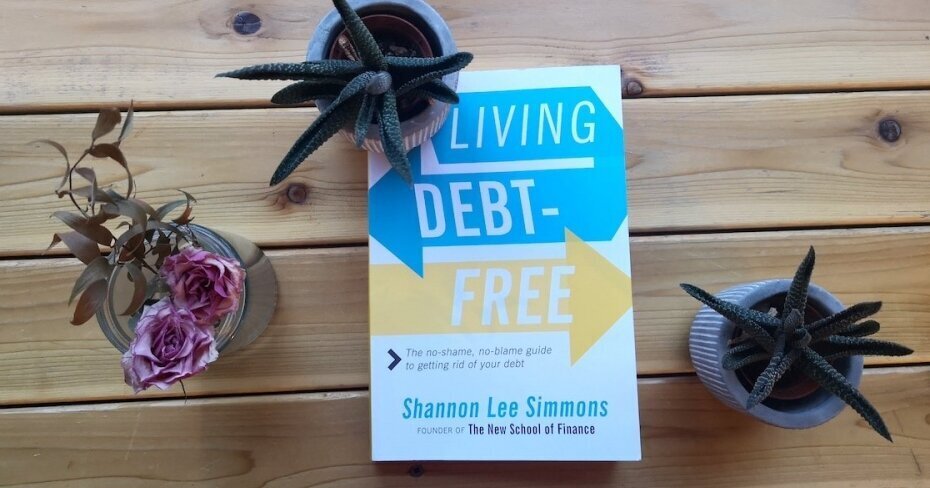Shannon Lee Simmons wants you to say goodbye to debt guilt
By: Lisa Coxon on December 31, 2018
If you’re anything like me, you probably operate with a general sense of ignorance when it comes to your debt. Ignorance, it’s worth pointing out, is not the same as irresponsibility. You make the required payments, even well above the minimums, but do you ever stop and think — like, really think — about the total debt you owe, and how long it’s going to take you to pay it back? My guess is no. Because that would induce an overwhelming sense of panic, fear, disappointment, and worst of all, guilt.
Guilt is a consequence of debt. There’s no way around it. If I didn’t purchase X then, I wouldn’t owe Y now. In order to pay it back, maybe you try restricting your weekly or monthly spending to an unrealistic amount, and, like any crash diet, you fail miserably and wind up using credit to bail yourself out. The guilt returns. Over time, you get used to the identity of being someone who has debt, which, in turn, just makes you feel more guilty.
Certified financial planner, expert, writer, and life coach Shannon Lee Simmons turns debt guilt on its head in her latest book, Living Debt-Free: The no-shame, no-blame guide to getting rid of your debt. Instead of shaming readers for spending $4 on a latte, Simmons pushes us to reframe our debt story in a positive way, confront our spending triggers, and shows us that we can still spend money and pay down debt at the same time. (Simmons doesn’t actually like traditional budgeting. You and me both, sister.)
Released in December, the book centers around Simmons’s aversion to the “shame and blame mentality” that so often surrounds debt. She sees no use for it, and she hammers this home throughout the book. It’s what makes her approach to debt so fresh and relatable. Instead of looking at your debt and asking yourself, “How could I?”, Simmons wants you to ask, “What happened?”
She doesn’t want the exorbitant amounts of interest you’re paying to be the only thing that motivates you to pay down your debt faster. That’s guilt. Instead, she wants to help readers figure out what spending triggers got them to where they are now, and to choose to pay down their debt rather than feel like they have to. “No matter how you look at it,” Simmons writes, “new debt means less money for your daily life.” If Simmons had her way, we’d all be spending money, saving money and paying back our debt all at the same time.
First, Simmons introduces readers to the concept of the Debt Loop, which is the vicious cycle (unique to each person) that sees them taking on debt, trying to pay it back in an unrealistic way, failing hard, feeling guilty for having failed, and then having a “fuck-it moment,” which leads to a splurge on credit because hey, what’s another $200 on the heaping debt pile? Whew. Been there.
What gets us caught up in the Debt Loop is something Simmons calls “financial tripwires,” which can be either routine or emotional. These are expensive curveballs life throws you “that you didn’t plan for financially and that you feel your only option is to pay for with credit,” like, say, unexpected car repairs or a brand new outfit for a work holiday party. Simmons gets all of her clients — and readers — to identify their tripwires. An emotional tripwire could be positive or negative, but the common thread is that spending money is based on a feeling. Routine tripwires are more habitual in nature.
Take Lesley, for example, a client who wound up back in Simmons’ office with $9,000 on her credit card just one year after making a debt repayment plan. Simmons asked Lesley what she asks all of her clients: How did you get here? Was it a slow burn or did it all come at once?
First, Simmons introduces readers to the concept of the Debt Loop, which is the vicious cycle (unique to each person) that sees them taking on debt
She had Lesley review five months’ worth of credit card statements (something she does with every client) and highlight any expenses that she now regrets. She calls this Unhappy Spending. When Lesley was finished highlighting, Simmons spotted a trend. All of Lesley’s Unhappy Spending was taking place during the week. But it wasn’t happening after work.
“Lesley,” Simmons said.
“Yes?”
“I think you’re bored on your lunch break.”
Just like that, Simmons had determined Lesley’s routine tripwire. Wanting to get out of the office over her lunch break, Lesley would walk around the mall. But while she was there, she would make several small purchases on credit that, over time, really added up. With Simmons’s help, Lesley changed up her lunchtime routine, which partly involved leaving the credit card at the office when she went out for her break.
As I made my way through the book, I was shocked at Simmons’s ability to find a way to get her clients on track with a repayment plan that didn’t leave them broke, even when they couldn’t see a way out. It’s like she’s part therapist, part financial planner. Does that make her a financial therapist? No, wait. A debt magician? All of the above?
These are the best parts of Living Debt-Free: the often laugh-out-loud conversations between Simmons and her many clients that you, the reader, get to listen in on like a fly on the wall. With each interaction, we get to know Simmons as a whip-smart and compassionate person, and we get to see ourselves in so many of her clients. Like when she’s talking to Mandi, a recent graduate who, after moving back home with her parents and overhearing them argue about their ability to pay down debt, felt so guilty after racking up $7,000 worth on her credit card shortly after because she wasn’t financially prepared to move out on her own. She felt irresponsible with money.
“You were the total opposite—you were too financially responsible, and very selfless,” Simmons tells her.
“That definitely makes it easier to swallow,” Mandi replies. “You make me feel like some sort of financial superhero.”
“You are,” Simmons says, “and helping people you love is your financial kryptonite.”
Being privy to these conversations makes you want to hang out with Simmons and just talk debt for a day because somehow, she makes the topic enthralling and surrounds the conversation with what feels like a warm hug.
It’s not all sunshine and rainbows, though. Simmons is realistic about the fact that sometimes debt just gets unmanageable, and when that happens, there might be no other way out than with more drastic measures, like applying for a debt consolidation, filing a consumer proposal, or, yes, even bankruptcy. She also acknowledges early on in the book that the strategies she’s putting forth will only work best for people who have some form of income or the potential to earn one.
Over the next 14 chapters, Simmons introduces readers to concepts that take all of the guesswork out of debt repayment. She gives them clever names, too. Like your Debt Map (a big-picture chart of everything that you owe, including your total minimum payment, interest rates, and statement dates); Debt Stacking (where you tackle the debt with the highest-interest rate first, then re-allocate that minimum payment to the others); using Debt Slammers, such as lump sums, to make big dents in your debt; and your Magic Amount (the amount of money you can throw at your debt on top of your minimum payment, after you determine your fixed expenses and average monthly spending money.) Broken down like this, paying back debt actually feels achievable. It just requires a bit of mathematical digging.
Perhaps the most unique weapon in Simmons’ arsenal is her Strategic Banking plan. The thing about Simmons is, she sees debt from all angles. She’s got you when it comes to financial tripwires. She can teach you how to stack your debt. And she can help you determine your Magic Amount. But she can also spot flaws in your banking set up that might be making it harder to keep track of everything. See, I told you. Debt magician.
Being privy to these conversations makes you want to hang out with Simmons and just talk debt for a day. . . she makes the topic enthralling and surrounds the conversation with what feels like a warm hug
“If all your money goes in and out of one chequing account,” Simmons writes, “it’s really hard to know when you’re safe to spend money and when you’re not. I call this the Spending Vortex. The Spending Vortex robs you of your ability to know when you can or cannot afford something.”
She suggests renaming your existing chequing account (the one that your paycheck gets deposited into) “Bills and Savings,” and automating all your fixed expense payments and short-term savings (money you’re saving today so you can spend tomorrow) to come out of this account. Next, she wants you to open a second chequing account that your debit card is linked to, and name it “Spending Money.” Each pay period, move only your spending money into this account. (You’ll have determined this amount early on in the process.) Now your spending money is isolated from your fixed expenses.
Damn, I thought. That’s kind of brilliant.
The only criticism I have of the book is that it gets a little exhausting reading so many peoples’ debt maps. After a while, the numbers started to blur together. I started skimming over the charts themselves and focused on the text to find out the juicy details, like how many months Simmons was able to shave off of her client’s debt repayment plan. That’s where the magic is.
I’m reading this book at a pivotal moment. Earlier this year, I went to an event where I saw a few financial planners (Simmons being one of them) speak on the topic of women and money management, and it got me thinking: why haven’t I seen a planner yet? At 29, it feels like the responsible thing to do. I’m not quite at the point yet where I’m prepared to invest or save huge chunks of money for retirement. First, I need help with debt repayment. I want to take stock of all that I owe and I want a detailed, achievable plan, put in place by someone who knows money that will help me actually pay it off — for good. So, I booked an appointment with someone at Simmons’s firm. It seemed fitting that, a few weeks later, Living Debt-Free came out, and I got the green light from my editor to review it.
A lot of the homework I’ve been given in advance of that appointment is similar to what’s in this book. After reading it, I flirted with the idea of cancelling the appointment, saving my money, and just doing it on my own. But I don’t think a book can provide all the answers. Every situation is unique, and because this is the first time I’m getting real about my financial future, I believe only a face-to-face encounter will do. I’m still expecting to hear a lot of what’s in this book, but I’m curious what other revelations will come up during my appointment. Like what are my financial tripwires? I’m hoping to get answers to some things that are a little less obvious than just the numbers.
Thing is, I’m not irresponsible with my debt. I’ve just never committed to a structured repayment plan. My repayments are a little frantic and usually — you guessed it — driven by guilt. Also, I continue to use credit even as I’m working to pay it back, which is a big no-no, according to Simmons. Right now, the idea of being debt-free is laughable to me. Everyone has debt, we tell each other. But this mentality, Simmons says, is a big part of what’s preventing people from getting out of debt: the belief that we’re bad with money. That only perpetuates the problem.
I’ve been telling all my friends about this book — about its fresh outlook on what debt is, about its guilt-free approach to paying it back, and about it being realistic for, well, real people. Each of them has said they’re going to buy it. For a book about debt, that’s a hard sell.
In the opening pages of her book, Simmons writes: “If you’re tired of being in debt and tired of failing at debt-repayment plans, welcome. I’m so glad you found me.”
Me, too, Shannon. Me too.


